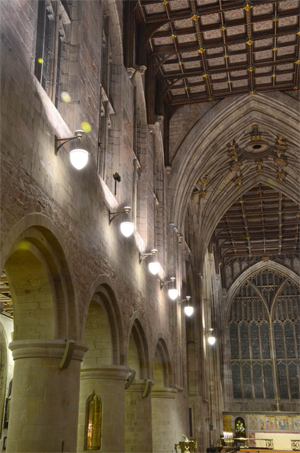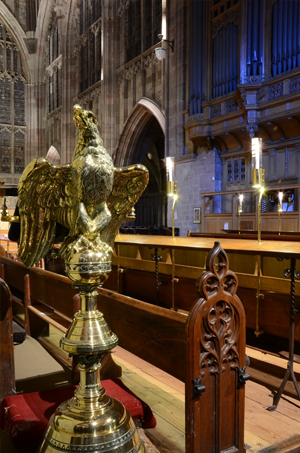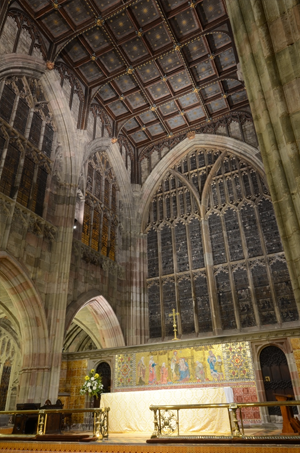A lighting requirement? One church's perspective
 Considerations other than cost need to be made when engaging a contractor for a church lighting project.
Considerations other than cost need to be made when engaging a contractor for a church lighting project.
Anthony J Smith (Gloucester) Ltd has recently completed a project to install new lighting throughout Great Malvern Priory which is part of the Greater Churches Network. The priory is a Grade I listed building and is a focal point both in Malvern and in the Diocese of Worcester.
 The priory receives over 30,000 visitors each year and has a large worshipping congregation. Services are held every day of the year and the building is extensively used by the local community. The challenge was to replace the 1960's lighting with a new energy efficient, low maintenance lighting installation, suitable for the many and varied activities that take place in the building, while minimising the disruption during the installation period.
The priory receives over 30,000 visitors each year and has a large worshipping congregation. Services are held every day of the year and the building is extensively used by the local community. The challenge was to replace the 1960's lighting with a new energy efficient, low maintenance lighting installation, suitable for the many and varied activities that take place in the building, while minimising the disruption during the installation period.
A wide-ranging exercise was carried out by the Priory's Lighting Project Group to determine the requirements for the new lighting, including visiting several other churches with new lighting installations. The result was the production of a Design Brief that specified the various lighting requirements, and ensured that the primary purpose of the building as a place of worship was not lost in a desire to illuminate the features of the building.
 The group considered employing separate lighting design consultants and installation contractors, but chose instead to seek a company that was capable of handling the whole process including both design and installation.
The group considered employing separate lighting design consultants and installation contractors, but chose instead to seek a company that was capable of handling the whole process including both design and installation.
Proposals based on the Design Brief were received from three companies who offer a lighting design and installation service, and Anthony J Smith (Gloucester) Ltd was subsequently appointed. Anthony J Smith was formed in 1972 and specialises in lighting church and ecclesiastical buildings.
The new lighting installation was designed by Neil Blake, director of Anthony J Smith, and incorporated energy efficient, high performance, low maintenance equipment. The design followed the Design Brief and provided for the different uses of the building including highlighting various building features for visitors, lighting for performances in various locations, and an all-important, even, non-directional layer of light through the building for services and other activities.
 Neil was also involved in many detailed discussions with the Lighting Project Group and the approving authorities including the Diocesan Advisory Committee, English Heritage and the priory architect. As the design was refined, Anthony J Smith offered technical support and demonstrations of the effects available by using different types of light fitting.
Neil was also involved in many detailed discussions with the Lighting Project Group and the approving authorities including the Diocesan Advisory Committee, English Heritage and the priory architect. As the design was refined, Anthony J Smith offered technical support and demonstrations of the effects available by using different types of light fitting.
The installation was completed by Anthony J Smith's own experienced and qualified engineers in a series of localised areas which allowed normal Ôchurch life to continue with the minimum of disturbance. Working hours and break-times were varied to suit the services, weddings and funerals scheduled for each week, and the installation was carried out with considerable attention to detail and care in concealing the cables.
The new priory lighting has been received with great excitement by both the regular congregation, who can now clearly see their hymn books, and by visitors who marvel at the ceilings and other features that had not previously been visible.
Michael Angling, the priory project manager, commented: "This was an excellent example of the contractor and client being flexible to the needs of each other which allowed the project to be brought to a very satisfactory conclusion".
The staff at Anthony J Smith (Glos)Ltd are an as experienced team as can be found working in this niche market. They have been involved in the designing and installing of tailored lighting solutions in many of our fine listed buildings both large and small for a very long time. There is no substitute for experience when dealing with these most important buildings and a good design is only half of the challenge. A sensitive installation of cabling is also of utmost importance as many Church interiors are spoilt by an untidy and unsuitable installation of cabling. Value for money and use of suitable technologies for the exacting needs of each individual Church should also be established at every stage of the project.
For more information about this and other projects visit www.anthonyjsmith.co.uk













